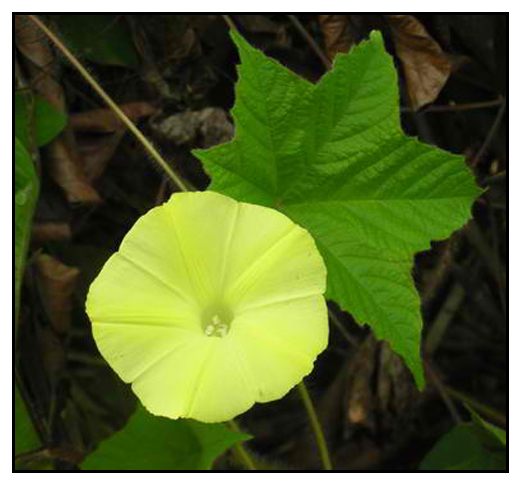
Family • Convolvulaceae
Lakmit
Merremia vitifolia (Burm. f.) Hallier f.
GRAPE-LEAF WOOD ROSE
Zhang ye yu huang cao
| Scientific names | Common names |
| Convolvulus angularis Burm. f. | Kalalakmit (Sul.) |
| Ipomoea vitifolia Burm.f. | Lakmit (Tag.) |
| Ipomoea vitifolia var. angularis (Burm.f.) Choisy | Grape-leaf wood rose (Engl.) |
| Merremia vitofolia (Burm. f.) Hallier f. | Grapeleaf merremia (Engl.) |
| Merremia vitifolia (Burm. f.) Hallier f. is an accepted nam. The Plant List | |
| Other vernacular names |
| BANGLADESH: Dudh lota. |
| CAMBODIA: Var moba mek. |
| CHINESE: Zhang ye yu huang cao. |
| INDONESIAN: Ginda purang utang, Areuy kawoyang, Dewulu, Bilajang bulu. |
| MALAYALAM: Manja kolambi valli, Manja vayaravalli. |
| MALAYSIA: Akar lulang bulu, Ulan raya, Lulang bulu. |
| MARATHI: Navli. |
| THAI: Ching chaw, Jingjoa, Jing-jor. |
| VIETNAMESE: B[if]m l[as]nho. |
Distribution Constituents Properties Studies Availability |
| Abuse and Plagiarism of the Compilation on Philippine Medicinal Plants Under the Guise of Fair Use |
Updated March 2020 / August 2016
![]()
 |
PHOTOS / ILLUSTRATIONS |
| IMAGE SOURCE: / Photo / Merremia vitifolia / Creative Commons: Attribution-NonCommercial 3.0 Unported (CC BY-NC 3.0) / Click on image to go to source page / Convolvulaceae Unlimited |
| Additional
Sources and Suggested Readings (1) CONVOLVULACEAE / Merremia Dennst. ex Endl. / Gen. Pl., Suppl. 1: 1403 (1841). (2) Merremia vitifolia / Synonyms / The Plant List (3) WILD EDIBLE CONVOLVULACEAN MEMBERS USED BY THE ULLADA TRIBES OF ALEPPEY DISTRICT, KERALA / Joseph M.A*and AntonyV.T / Journal of Science, Vol 4, Issue 7 (2014) pp 425-427. (4) ANTI-INFLAMMATORY ACTIVITY OF THAI TRADITIONAL REMEDY EXTRACT FOR MUSCLE PAIN TREATMENT CALLED SAHASTHARA AND ITS PLANT INGREDIENTS / MR. NARIN KAKATUM / Thesis / 2011 (5) Medicinal Plants Used by the Folk and Tribal Medicinal Practitioners in Two Villages of Khakiachora and Khasia Palli in Sylhet District, Bangladesh / Md. Enamul Kabir Shaheen, Md. Afser Syef, Sudhangshu Shekhar Saha, Md. Shariful Islam, Md. Din Al Hossain, Md. Ariful Islam Sujan, Mohammed Rahmatullah / Advances in Natural and Applied Sciences, 2010; 5(1): pp 9-19 (6) PHYTOCHEMICAL SCREENING OF SELECTED SPECIES FROM CONVOLVULACEAE / MARIA EMILIA MASCARENHAS*, CIBANI RAMESH MANDREKAR, PRATIKSHA BHARAT MARATHE, LUENA JOEY MORAIS / International Journal of Current Pharmaceutical Research, 2017; 9(6) / DOI: http://dx.doi.org/10.22159/ijcpr.2017v9i6.23438 (7) Annual Report on Essential Oils, Synthetic Perfumes, & C . . . / Schimmel & Co. Aktiengesellschaft, Miltitz bei Leipzig / Google EBook (8) Analysis of Flavonoid Contents from Extracet Ethanol Bilajang Bulu Leaf (Merremia vitifolia) / Ella Hasanah, Ni Komang Ayu, Dela Puspila, Sukarti / Indonesia Chimica Acta, June 2019; 12(1) (9) Pharmacologic insights into Merremia vitifolia (Burm.f.) Hallier f. leaf for its antioxidant, thrombolytic, anti-arthritic and anti-nociceptive potential / Sahida Akter, Israt Jahan, Mst Riniara Khatun, Mhammed Forhad Khan, Laiba Arshad, Md Jakaria, Md Areeful Haque / Bioscience Reports, 2021; 41(1): BSR20203022 / DOI: https://doi.org/10.1042/BSR30303022 (10) Activity Test of Leaf Ethanol Extract Bilajang Bulu Merremia vitifolia Againsts Staphylococcus aureus Bacteria / Ella Hassanah, Sukarti, Ni Komang Ayu, Dela Puspita / Al-Kimia, 2020; 8(1): pp 29-35 / DOI: 10.24252/al-kimiav8i1.6368 |
DOI: It is not uncommon for links on studies/sources to change. Copying and pasting the information on the search window or using the DOI (if available) will often redirect to the new link page. (Citing and Using a (DOI) Digital Object Identifier) |
• |
| List of Understudied Philippine Medicinal Plants |
 |

 Botany
Botany